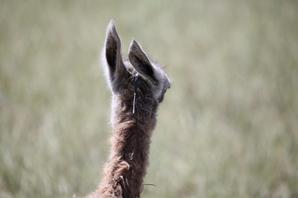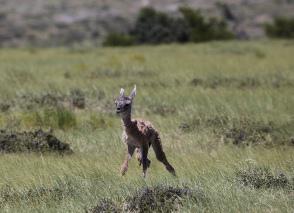Mariel Ruiz Blanco
This project aims to:
(i) investigate guanaco mortality patterns during their first year of life, and
(ii) evaluate potential effects of puma predation of juveniles on population dynamics.

Radio ear-tagged guanaco just before the reunion with its mother. © Maxi Montero.
The guanaco (Lama guanicoe) is the dominant large herbivore of South American semi-arid ecosystems. They were the main puma (Puma concolor) prey until they suffered a >90% population decline due to hunting and livestock raising. Most populations are fragmented into smaller and many times isolated populations with very low densities (<5 guanacos/km2). Currently, they are ecologically extinct at a local scale along a great proportion of their distribution, where they were replaced by livestock and exotic species. Intense predation in areas where pumas are supplemented by livestock and exotic prey could be preventing recovery of low-density guanaco populations.

Neonate guanaco born 20 minutes ago. © Maxi Montero.
It is known from previous studies that pumas prey on juvenile guanacos (0-12 months) more frequently than on adults. We will investigate guanaco mortality patterns during their first year of life, and evaluate potential effects of puma predation of juveniles on population dynamics, better understanding the factors that limit guanaco population growth. To approach this goal we will radio ear-tag guanaco newborns and monitor them during the first year of life in La Payunia Provincial Reserve, Mendoza, Argentina. This reserve was created to protect one of the last and largest migratory guanaco populations. Guanaco conservation and recovery will be successful only if we understand the role of predation on population dynamics.